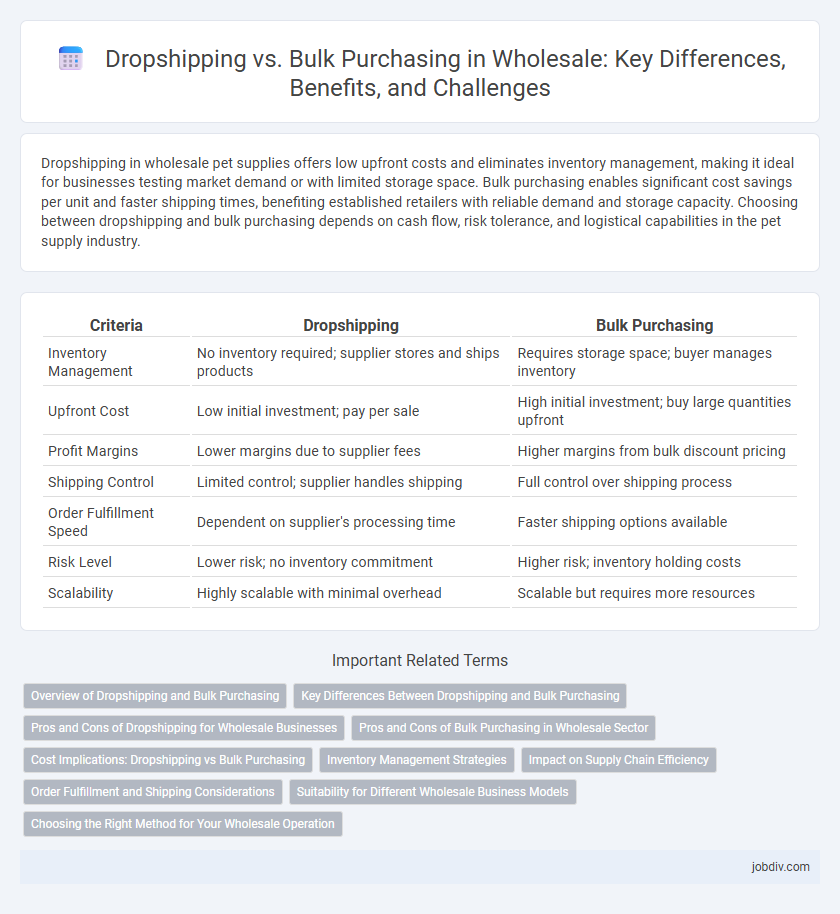Dropshipping in wholesale pet supplies offers low upfront costs and eliminates inventory management, making it ideal for businesses testing market demand or with limited storage space. Bulk purchasing enables significant cost savings per unit and faster shipping times, benefiting established retailers with reliable demand and storage capacity. Choosing between dropshipping and bulk purchasing depends on cash flow, risk tolerance, and logistical capabilities in the pet supply industry.
Table of Comparison
| Criteria | Dropshipping | Bulk Purchasing |
|---|---|---|
| Inventory Management | No inventory required; supplier stores and ships products | Requires storage space; buyer manages inventory |
| Upfront Cost | Low initial investment; pay per sale | High initial investment; buy large quantities upfront |
| Profit Margins | Lower margins due to supplier fees | Higher margins from bulk discount pricing |
| Shipping Control | Limited control; supplier handles shipping | Full control over shipping process |
| Order Fulfillment Speed | Dependent on supplier's processing time | Faster shipping options available |
| Risk Level | Lower risk; no inventory commitment | Higher risk; inventory holding costs |
| Scalability | Highly scalable with minimal overhead | Scalable but requires more resources |
Overview of Dropshipping and Bulk Purchasing
Dropshipping allows retailers to sell products without holding inventory, as suppliers ship items directly to customers, minimizing upfront costs and reducing storage needs. Bulk purchasing involves buying large quantities of products at discounted rates, enabling higher profit margins but requiring significant initial investment and storage space. Both methods serve different business models, with dropshipping favoring low-risk entry and bulk purchasing supporting scalability and inventory control.
Key Differences Between Dropshipping and Bulk Purchasing
Dropshipping eliminates inventory storage by directly shipping products from suppliers to customers, reducing upfront investment and risk, while bulk purchasing involves buying large quantities upfront to secure lower prices and greater control over stock. Dropshipping offers flexibility and scalability without holding physical inventory, whereas bulk purchasing demands significant capital but allows faster fulfillment and better profit margins. Understanding these differences helps businesses choose between operational agility and cost efficiency based on their supply chain strategy.
Pros and Cons of Dropshipping for Wholesale Businesses
Dropshipping enables wholesale businesses to minimize inventory costs and reduce upfront investment by forwarding customer orders directly from suppliers, which enhances cash flow management and scalability. However, reliance on third-party suppliers can lead to inconsistent product quality, longer shipping times, and less control over inventory availability, potentially impacting customer satisfaction. Despite these challenges, dropshipping offers flexibility and lower risk, making it an attractive option for new or small-scale wholesale operations.
Pros and Cons of Bulk Purchasing in Wholesale Sector
Bulk purchasing in wholesale offers significant cost savings per unit and streamlined inventory management for businesses with consistent demand. However, it requires substantial upfront capital investment and increased storage space, which can lead to higher holding costs and risks of overstock or inventory obsolescence. Businesses must carefully balance bulk order advantages against potential cash flow constraints and warehousing limitations to optimize profitability.
Cost Implications: Dropshipping vs Bulk Purchasing
Dropshipping minimizes upfront inventory costs by allowing retailers to purchase products individually per customer order, reducing storage expenses and risks associated with unsold stock. Bulk purchasing requires significant capital investment but offers lower per-unit costs, enabling higher profit margins through economies of scale. Careful analysis of order volume, cash flow, and storage capacity is essential to determine the most cost-effective wholesale strategy for a business.
Inventory Management Strategies
Dropshipping minimizes inventory holding costs by allowing retailers to sell products without maintaining stock, relying on suppliers to fulfill orders directly. Bulk purchasing requires substantial upfront investment and storage but enables greater control over inventory, pricing, and faster shipping times. Effective inventory management strategies balance demand forecasting, supplier reliability, and cost efficiency to optimize stock levels and minimize fulfillment delays.
Impact on Supply Chain Efficiency
Dropshipping reduces inventory holding costs and minimizes storage needs by shipping products directly from suppliers to customers, enhancing supply chain agility. Bulk purchasing streamlines procurement processes and negotiates better pricing, but requires robust inventory management and warehousing resources. Efficient supply chain operations depend on balancing dropshipping's flexibility with bulk purchasing's economies of scale to optimize order fulfillment speed and cost-effectiveness.
Order Fulfillment and Shipping Considerations
Dropshipping streamlines order fulfillment by directly shipping products from suppliers to customers, minimizing inventory holding and upfront costs but potentially increasing shipping times and reducing control over packaging quality. Bulk purchasing requires maintaining inventory and managing warehousing, which allows faster order processing and customized packaging but involves higher storage costs and risks of unsold stock. Efficient shipping considerations for dropshipping include reliable supplier partnerships and real-time tracking integration, while bulk purchasing demands optimized logistics and bulk shipping discounts to lower overall distribution expenses.
Suitability for Different Wholesale Business Models
Dropshipping suits businesses seeking low upfront investment and flexible inventory management by allowing products to be shipped directly from suppliers to customers without holding stock. Bulk purchasing benefits wholesale models with established capital and storage capacity, enabling lower per-unit costs and greater control over inventory. Selecting between dropshipping and bulk purchasing depends on factors like cash flow, storage resources, and scalability objectives within the wholesale market.
Choosing the Right Method for Your Wholesale Operation
Dropshipping offers low upfront costs and minimizes inventory risks, ideal for businesses seeking flexibility and reduced overhead in their wholesale operation. Bulk purchasing provides higher profit margins and better control over stock but requires significant capital and storage capacity. Selecting the right wholesale method depends on your cash flow, market demand, and operational resources to balance risk and scalability effectively.
Dropshipping vs Bulk Purchasing Infographic

 jobdiv.com
jobdiv.com